Haval H6 GT plug-in hybrid 2025 review
Part of a fresh breed of plug-in hybrid family cars, the Haval H6 GT PHEV has its eyes on Outlander and Sealion 6, but does it succeed?
The GWM Haval H6 GT PHEV is part of a new breed of Chinese plug-in hybrid SUVs that promise the world. With 180km of NEDC-rated electric driving range, a 0.8L/100km fuel consumption sticker, and a 1.5-litre petrol engine to back you up when the electrons run dry.
Following up on early adopter Mitsubishi Outlander’s recipe, the Haval H6 GT PHEV packages five seats into the apparently eco-friendly SUV with its Porsche Cayenne Coupe-like shape.
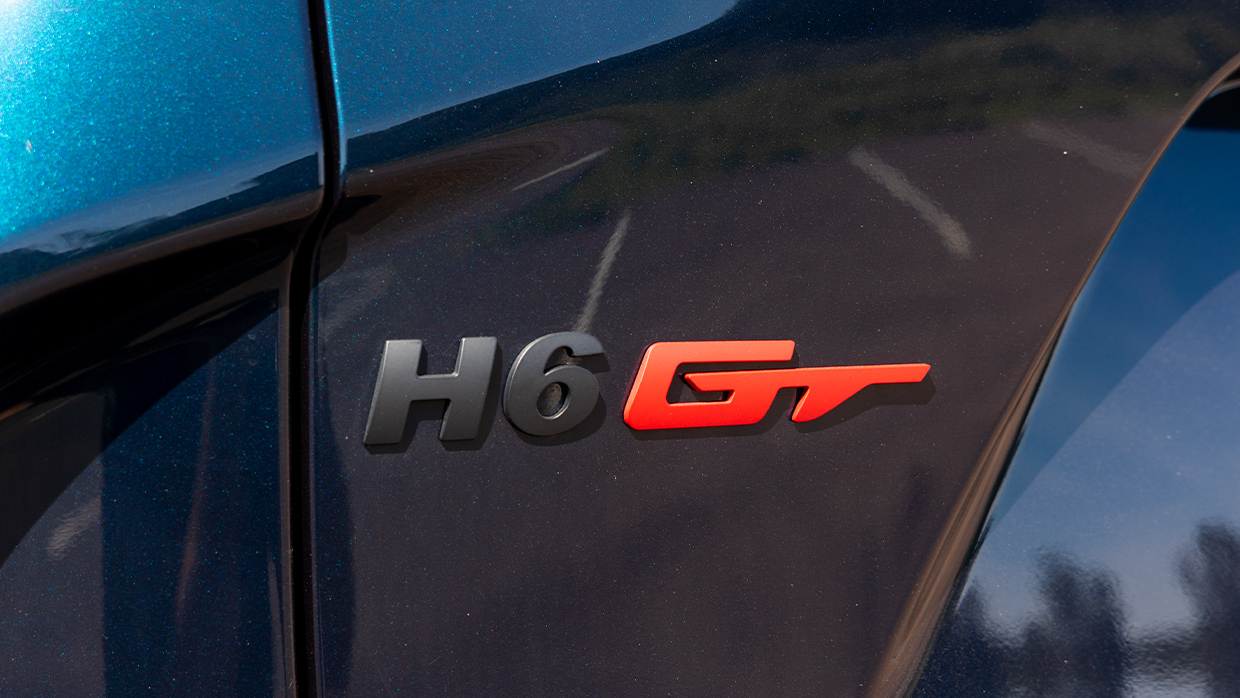
The H6 GT PHEV was pipped by the BYD Sealion 6, another plug-in rival from China, and the floodgates look set to open starting with the Jaecoo J7 and facelifted non-coupe Haval H6 later this year, followed by a similar variant of the new Leapmotor C10.
Think of the H6 GT as the first toe in the water for Haval, then. A good place to start as the more adventurously styled mid-sizer has found reasonable success, accounting for about a third of H6 sales in Australia.
Finished in a rather deep shade of Atlantis Blue — adventurous and worth it — the H6 GT may very well be to some people’s tastes. Not ours, though.
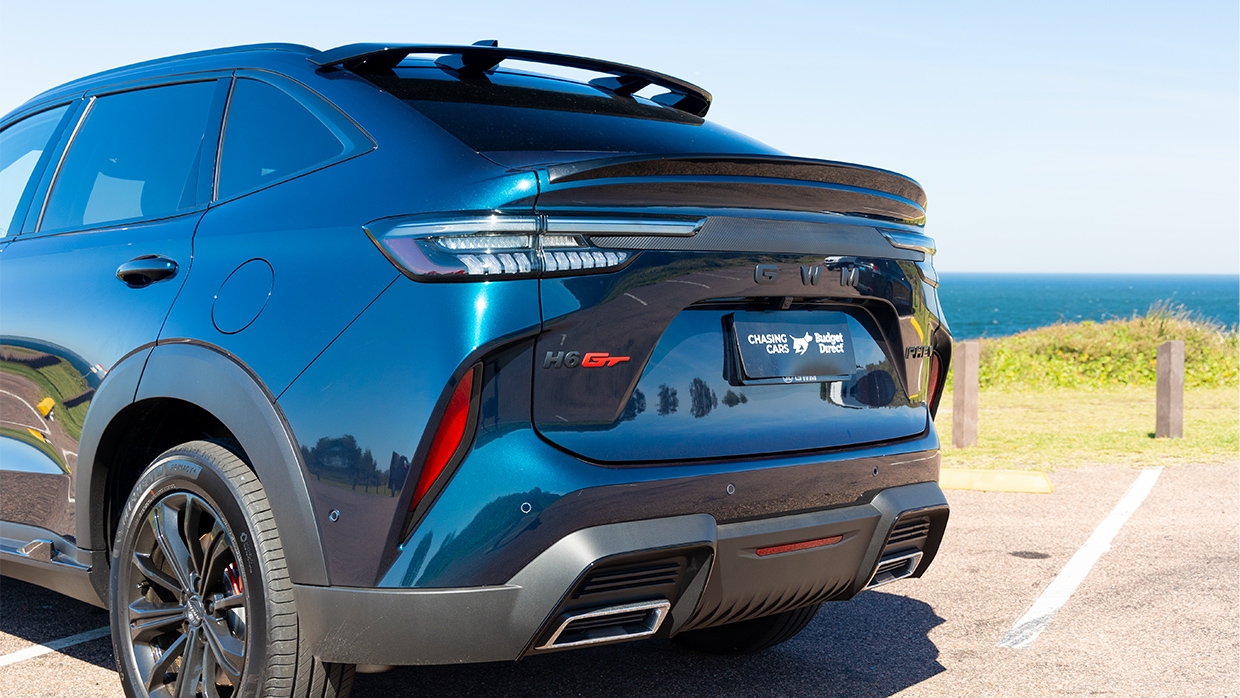
The big issue isn’t the silhouette, but the fussy details such as that wiggly roof spoiler, the overly busy rear diffuser and those 2000s (Max Power/Sex Spec)-style clear taillights.
What are the H6 GT PHEV’s features and options for the price?
Despite the H6 GT’s outgoing appearance, the price for its sole variant trim — called Ultra — is more than agreeable at $53,990 driveaway, handily undercutting the BYD Sealion 6 Premium ($52,990, before on-road costs) and Mitsubishi Outlander Aspire PHEV which is about $70K on the road.
A new entrant, the Jaecoo J7 PHEV, is cheaper again at $47,990 on-the-road, but it makes do with just front-wheel drive. With the Haval only available in one trim, it’s loaded up with everything GWM’s got.

The H6 GT PHEV feature highlights include:
- 19-inch alloy wheels
- Full LED exterior lighting
- Power tailgate with kick-to-open
- Keyless entry with push-button start
- 10.25-inch digital instrument cluster
- 12.3-inch multimedia touchscreen
- Wired Apple CarPlay and Android Auto
- Head-up display
- Voice control
- Eight-speaker sound system
- Artificial leather and suede upholstery
- Eight-way driver; four-way passenger power seat adjustment
- Heated and ventilated seats
- Heated steering wheel
- Wireless charging pad
- Five USB ports including for dash cam
- Panoramic sunroof
- 360-degree camera
How does the H6 GT PHEV drive?
First thing’s first, we have to tackle the outputs. GWM’s literature says a huge 321kW and 762Nm; more than really rather quick cars like an Audi RS3. The Haval H6 GT PHEV’s claimed 0-100km/h sprint is a stunning 4.9 seconds — equalling the smaller Cupra Formentor VZx.
In practice, the H6 GT PHEV feels less punchy than its heroic numbers suggest. That may be down to the PHEV’s 395kg weight penalty (2075kg) over the petrol version, but the powertrain’s unique plug-in set-up also contributes to the way the car responds.
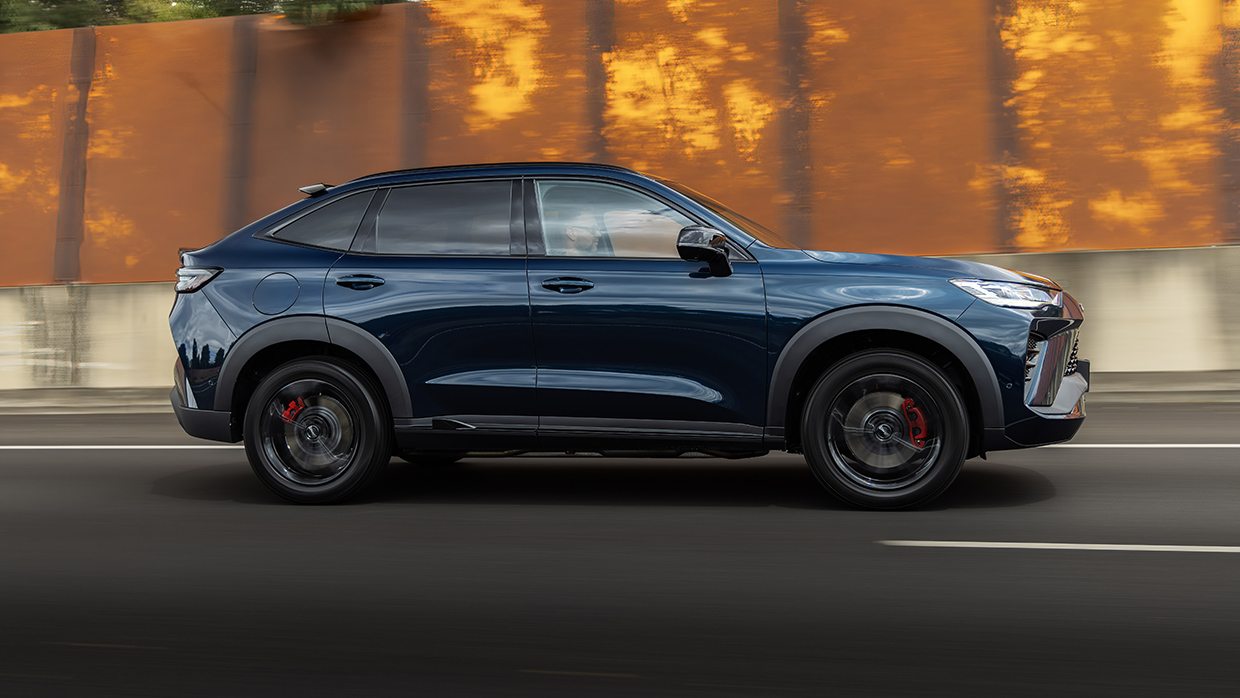
Up front, the petrol engine and electric motor work together to drive the front wheels through a two-speed transaxle, as in the regular H6 hybrid. Out the back, the 135kW rear motor runs its own race with a two-speed transmission. There’s no driveshaft connecting the front and rear axles in GWM’s Hi4T system.
Plus, because Haval’s focused on making the bulk of the power with electric motors — the petrol engine is a 110kW/230Nm turbo-petrol 1.5L four-cylinder — response is affected by drive mode, battery state-of-charge and the speed you’re travelling.
The H6 GT PHEV can charge its battery using regenerative braking. A pseudo one-pedal mode means that you can drive most of the time without pressing the left pedal but it isn’t as natural as a battery electric car. The brake pedal’s blending of regen’ and caliper braking is a little clumsy, too.
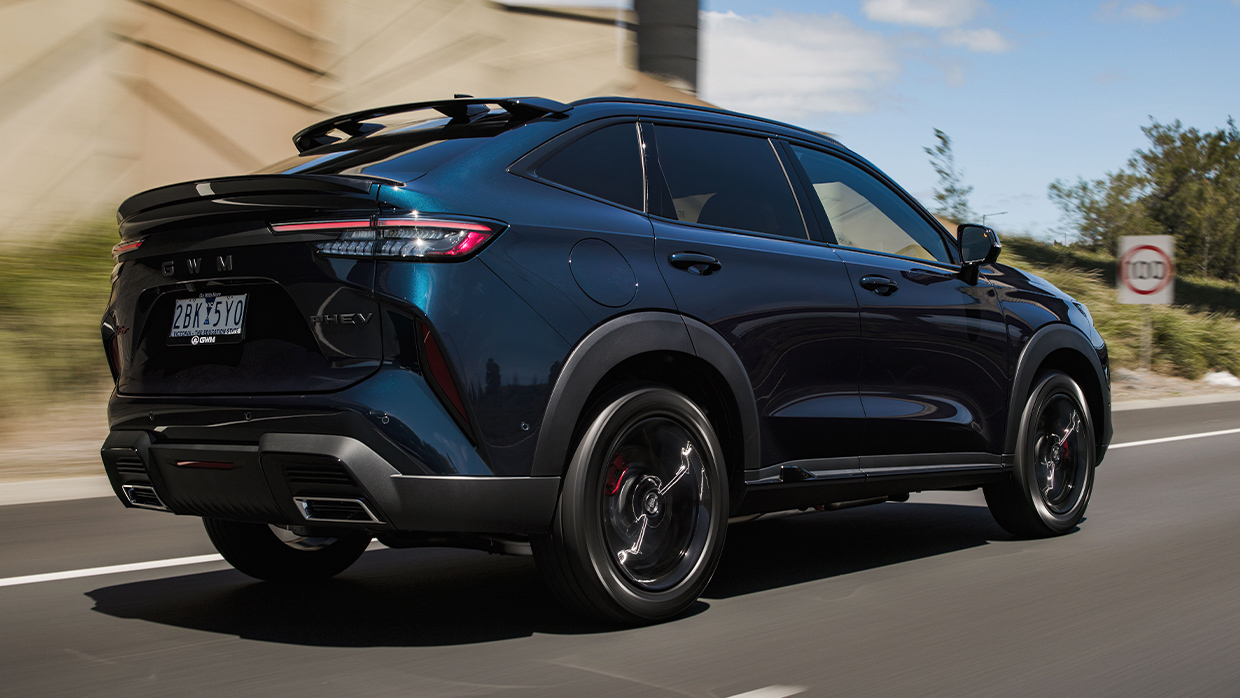
Back to the weight and you can feel the H6 is battling its extra kegs. Although down low, you can’t escape how mass affects crucial elements like ride and handling. The PHEV has a stiffer edge than its petrol counterpart and, especially at the rear, never seems to settle on small bumps.
Larger hits like speed-humps and depressions are cleared remarkably well, albeit with audible clunks from the suspension working away.
Similarly, the H6 GT PHEV is a capable handler with reasonable enough grip from its Michelin Primacy 4 tyres and safe, gentle understeer at the limit. Sadly, although nicely weighted, the electric power-assisted steering system is entirely uncommunicative.

Weight can be added to the wheel by selecting Sport mode, but doing so is a faff through the touchscreen that — oddly — also flashes the hazard lights three times.
What is the H6 GT PHEV’s interior and tech like?
As one of the first Chinese car makers to go big in Australia, the H6 GT was an early example of a Range Rover Evoque-inspired cabin with steering wheel and floating touchscreen above the dash. This now seems to be ubiquitous, just look at the Jaecoo J7.
In H6 GT Ultra trim, the PHEV retains the same hardware and layout today, and with the sheer speed of touchscreen size growth, is a little old hat. Not just visually, but the 12.3-inch multimedia screen has more content than it knows how to handle.
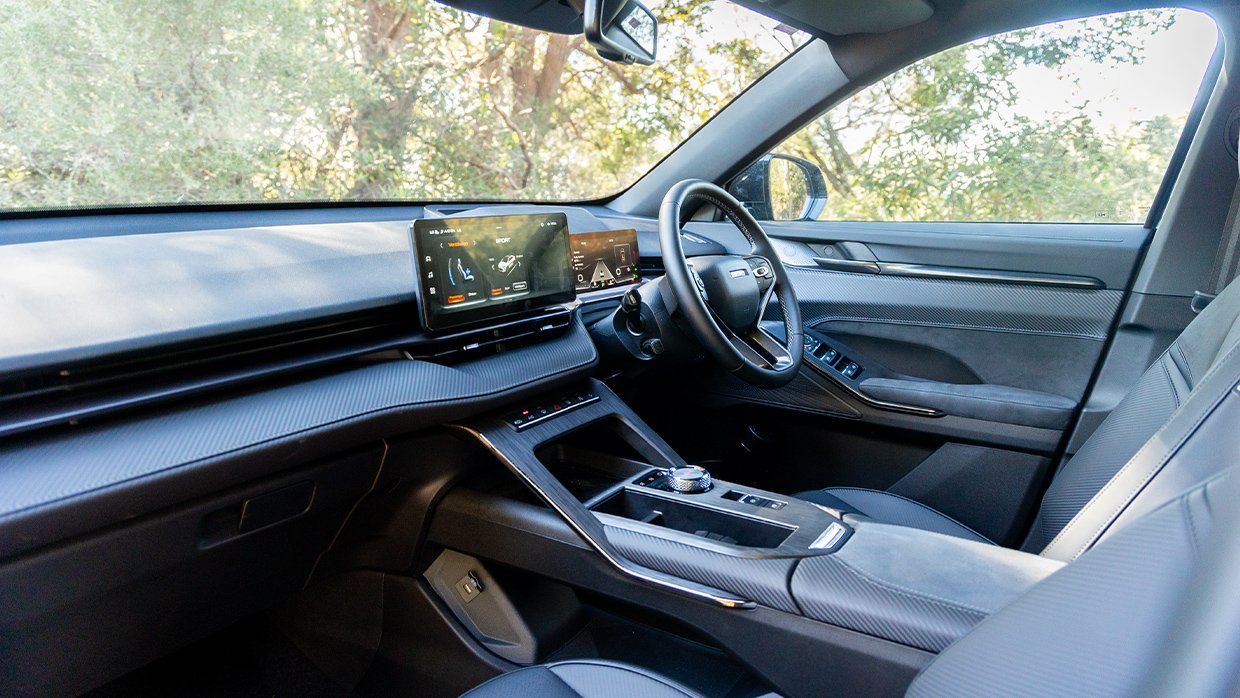
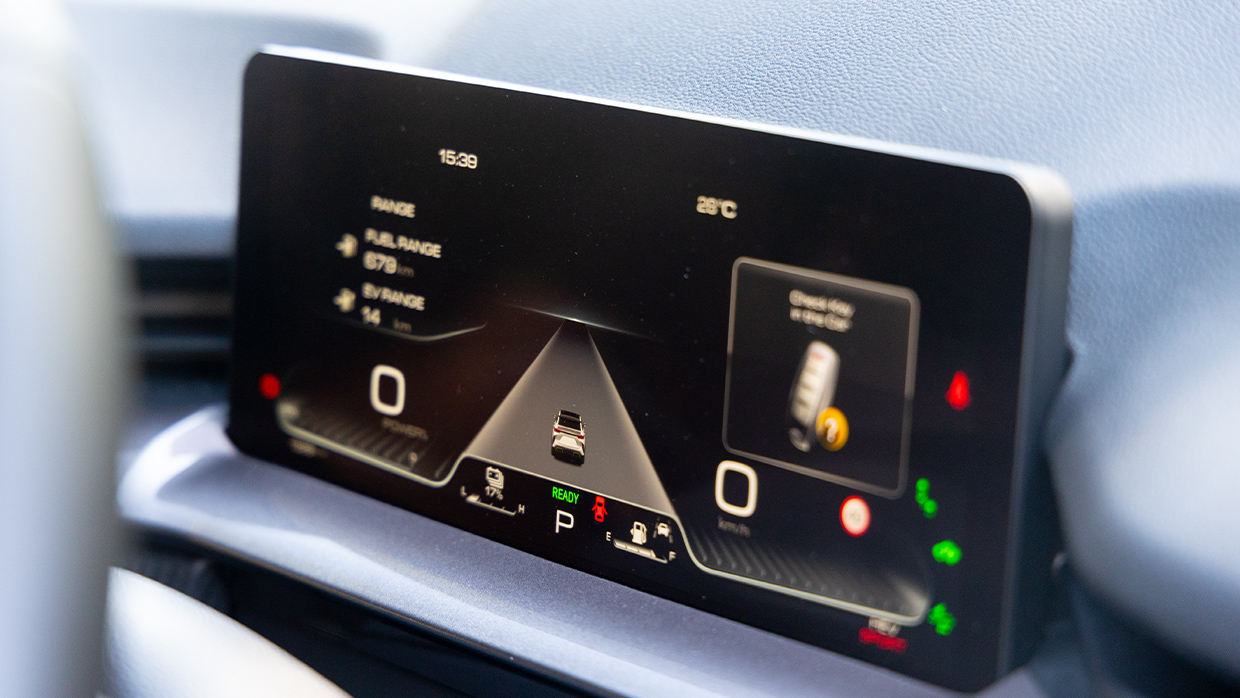
From Apple CarPlay and Android Auto (cabled only, via regular USB on passenger’s side of the centre console) to the climate controls, vehicle settings, volume control, drive modes, seat heating and ventilation, you’re constantly tapping forwards and back. Doesn’t help there’s lag in the software, either.
Trying to find the ventilated seat adjustment is a total pain as well, and the auto programming of the HVAC/seat/steering wheel temperature control just isn’t good enough to trust.
There are some pseudo-helpful pull-down menus — that you wouldn’t know about unless you accidentally touched the wrong spot — but they’re still overwhelming. Voice command worked quite well, at least, for particularly tricky functions like, erm, opening the sunroof blind.
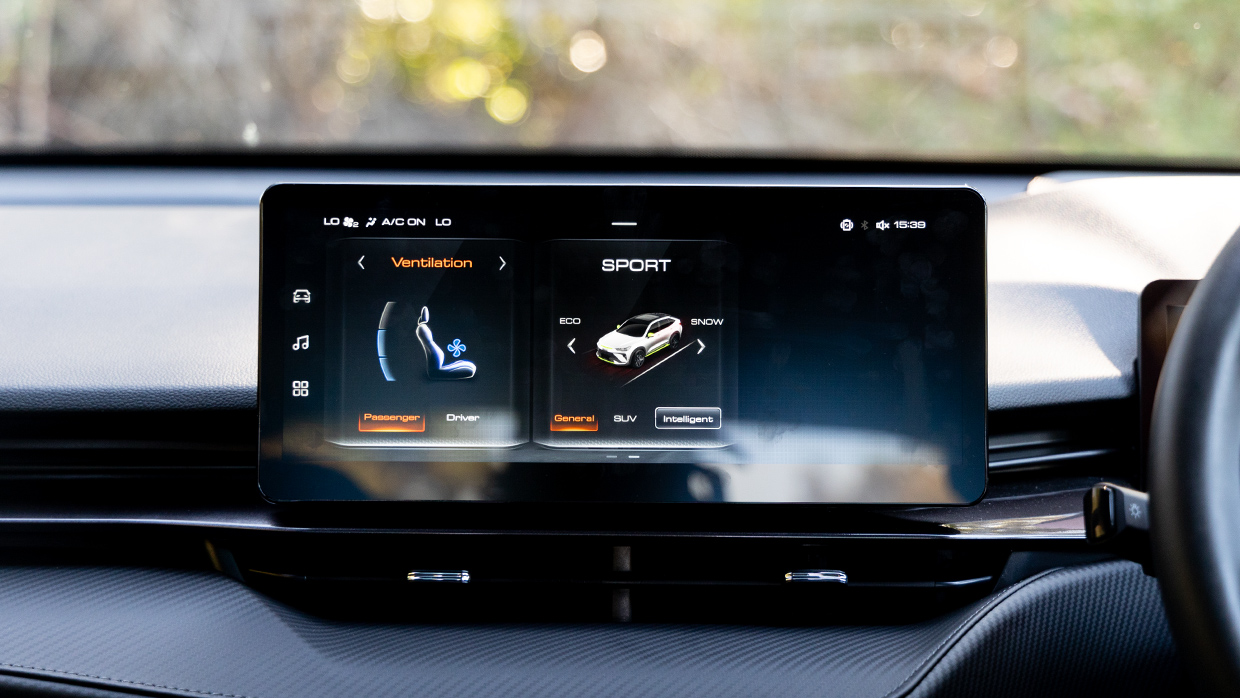
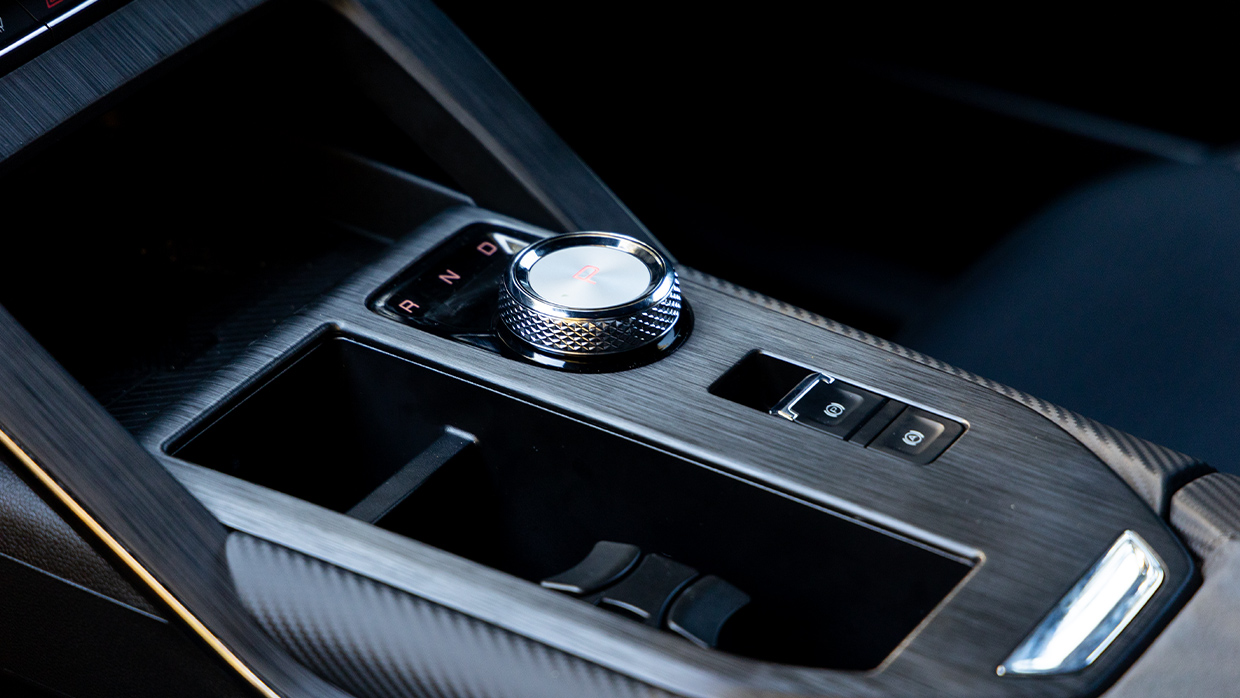
Storage is good, though, with a flying centre console that opens up space for tissue boxes and small bags below. Door bins accept a 600mL bottle and there’s covered storage under the centre armrest.
Seats have long been a shortcoming of the H6 line-up with insufficient under-thigh support and plasticky upholstery. There was a distinct mothball-like odour in the H6’s cabin, too. Still, it’s impossible to deny the sheer level of equipment on offer.
And the H6 GT PHEV is practical, the floor unaltered by the large battery beneath. Room is generous for adults and it’s a wide space, though the squab suffers the same under-thigh issues as the front seats.

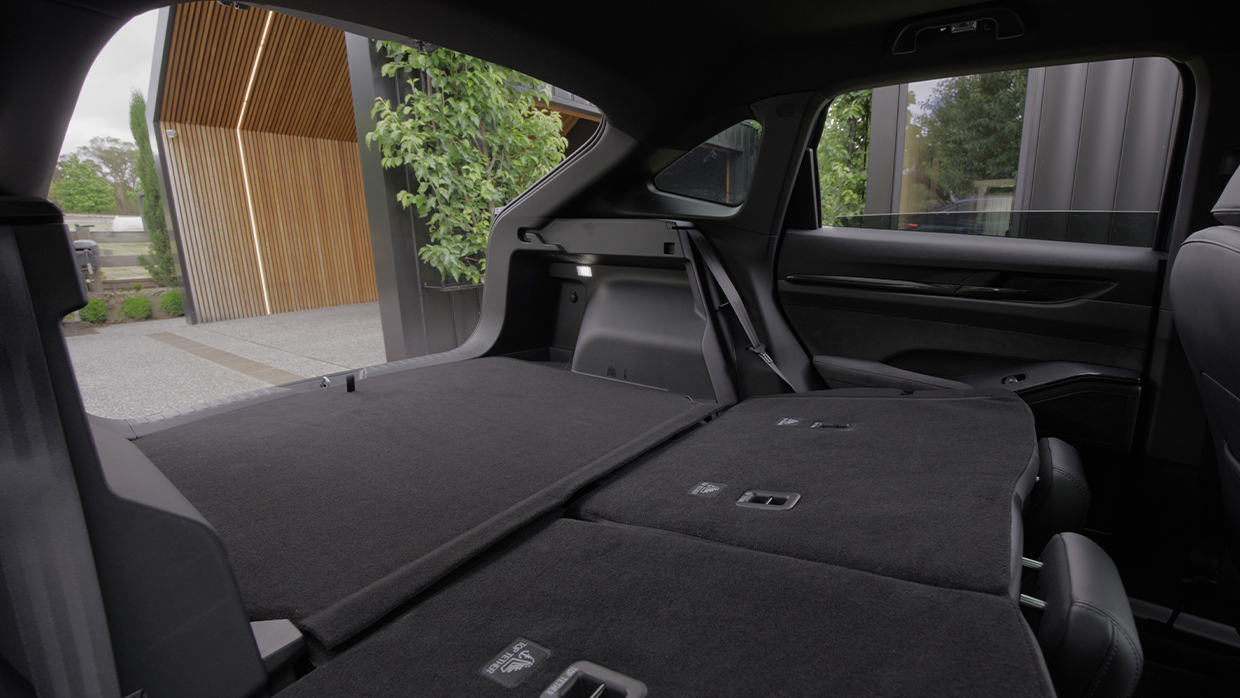
A pair of air vents and two more USB charge points are some nice creature comforts. The H6 GT PHEV has Isofix ports on the outboard seats and a trio of top tether anchor points on the seat back.
That sloping roof and high boot floor (to aid packaging the AWD hardware) don’t aid the H6 GT’s practicality, revealing a piddly (for its 4727mm length) 392-litre boot. For context, a standard H6 has a 600L boot. The battery gubbins also rob the PHEV of a spare tyre, and there are no other niceties in the H6 GT PHEV’s boot.
With an adapter, the plug-in hybrid battery can be used in vehicle-to-load (V2L) applications, powering devices up to 3.3kW.
Is the H6 GT PHEV a safe car?
The Haval H6 wagon was awarded a five-star ANCAP score against 2022 criteria, leaving the GT technically unrated.
Some of the latest technologies, including speed sign recognition and driver fatigue monitoring feature, along with the usual suite (see below) we’ve come to expect. Mostly, the H6 GT’s aids are acceptable though the lane-keep assist is more of a hindrance than a help, and the adaptive cruise control makes heavy inputs.

The H6 GT PHEV safety features include:
- Seven airbags, including centre unit
- Front and rear parking sensors
- Auto emergency braking (AEB) with pedestrian and junction assist
- Blind-spot monitoring
- Rear cross-traffic alert with brake
- Driver fatigue monitoring
- Lane-keep assist
- Traffic sign recognition
- Front and rear parking sensors
- Auto-park assist
- 360-degree camera
What are the H6 GT PHEV’s ownership costs?
The NEDC-based fuel consumption ratings are problematic and give little insight into the real-world energy use of plug-in hybrids. This car is a great example, because the catch-all claimed figure for the Haval H6 GT PHEV is a stunning 0.8L/100km, with 180km of electric-only range.
For a better idea on a longer run, we took the H6 GT PHEV on a mixed 200km loop, comprising urban, country and motorway driving and left the car to figure out how to best deploy energy sources.

The result was 3.4L/100km; probably more representative for someone who can charge a vehicle like this once a week. Driving around with the battery discharged saw this climb quickly to 5.4L/100km.
To motivate this two-tonne SUV at 110km/h on the motorway, the 1.5-litre petrol engine is working its absolute heart out and drinking 9.5L/100km in the process, so expect higher consumption on long trips.
Conversely, we found the Haval H6 GT PHEV’s electric-only range to be pretty impressive; expect closer to 150km than 180km but that’s still comparable to early electric cars like the Nissan Leaf and BMW i3.
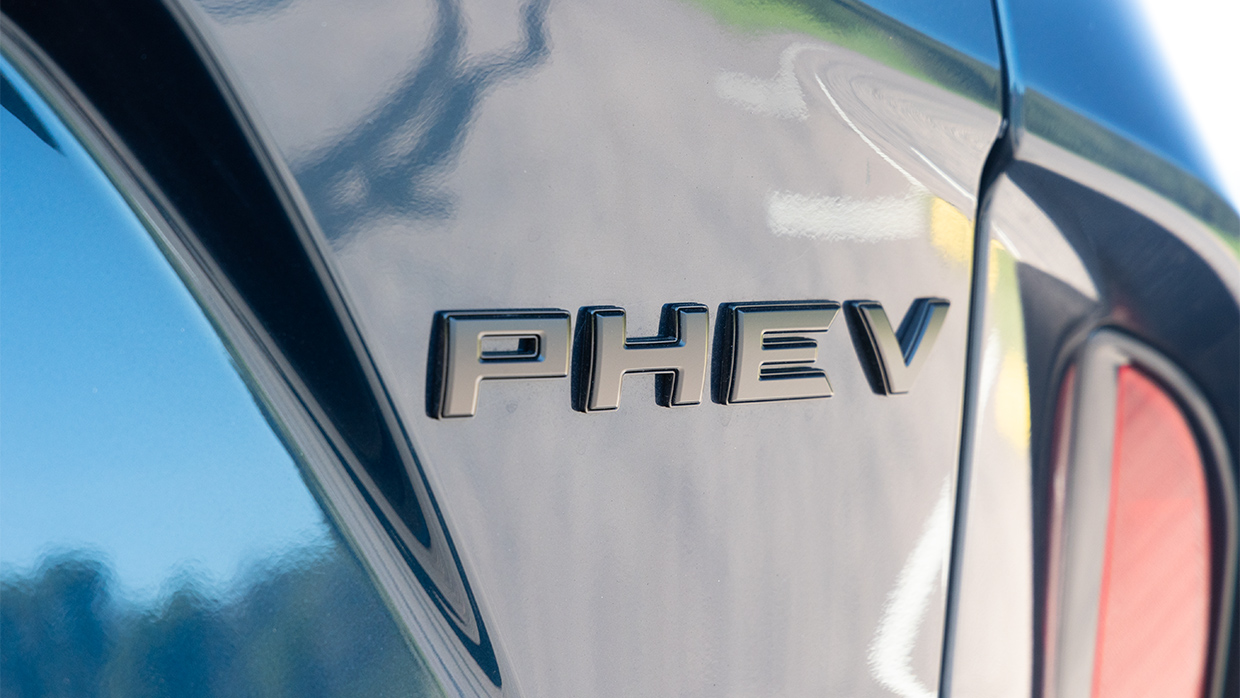
Combined EV and ICE driving range should be around 1000km thanks to the H6 GT PHEV’s generous 55L fuel tank.
The H6 GT PHEV has fast-charge ability, maxing out at 48kW DC, it can take the 35.4kWh battery from 30-80 percent SOC in 26 minutes. Using AC electricity, the rate is 6.6kW and a full rejuice takes around six hours.
GWM offers compelling after-sales support including a seven-year/unlimited kilometre warranty. MG and Nissan promote 10-year warranties, but both are kilometre limited and the Nissan stipulates servicing at a main dealer.
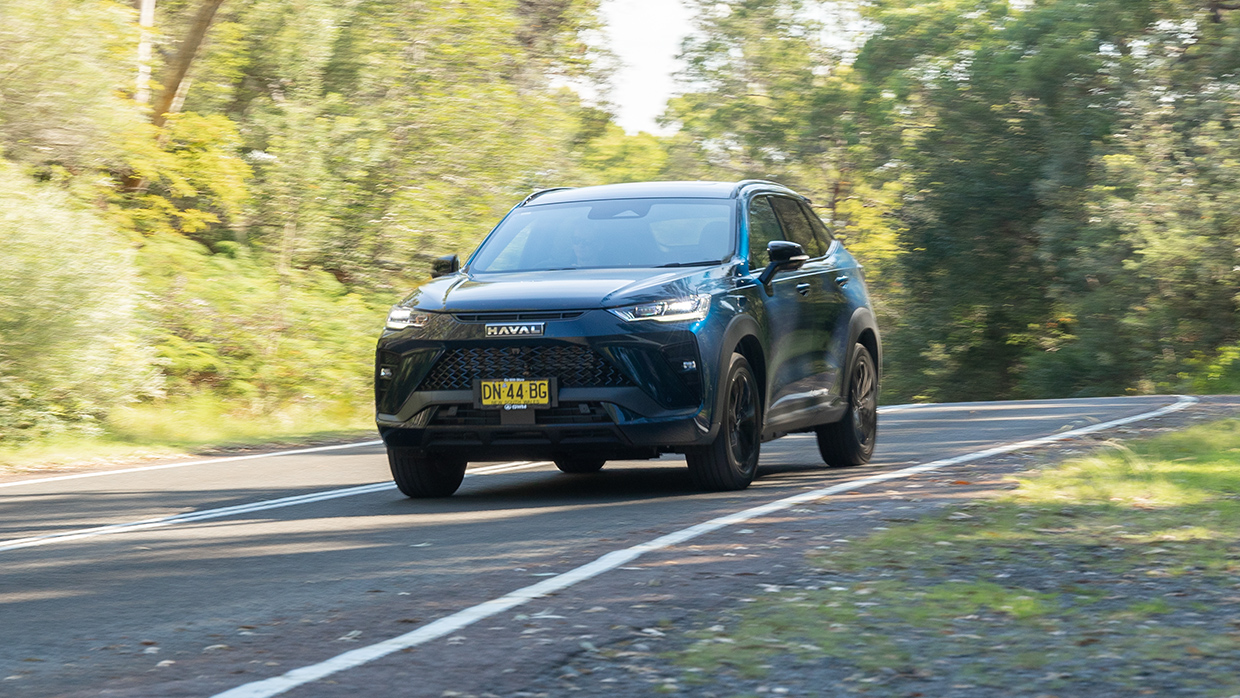
The H6 GT PHEV comes with five years of roadside assist and five years of capped price servicing — though pricing is yet to be locked in for the latter.
The petrol H6 GT requires maintenance first after 12 months/10,000km, and theme every year or 15,000km at a total cost of $2080 for five years, or an average of $416 annually.
The honest verdict on the H6 GT PHEV
If you can score a cracking deal and like the looks, the H6 GT PHEV offers a slice of visual difference, especially in Atlantis Blue like this car.
Electric-only driving range is superb, too, so if you keep it charged by finding cheap electricity the H6 GT will save you plenty of cash on petrol. Conversely, if you’re not charging disciplined or like a long drive, it’s worse than a regular hybrid.
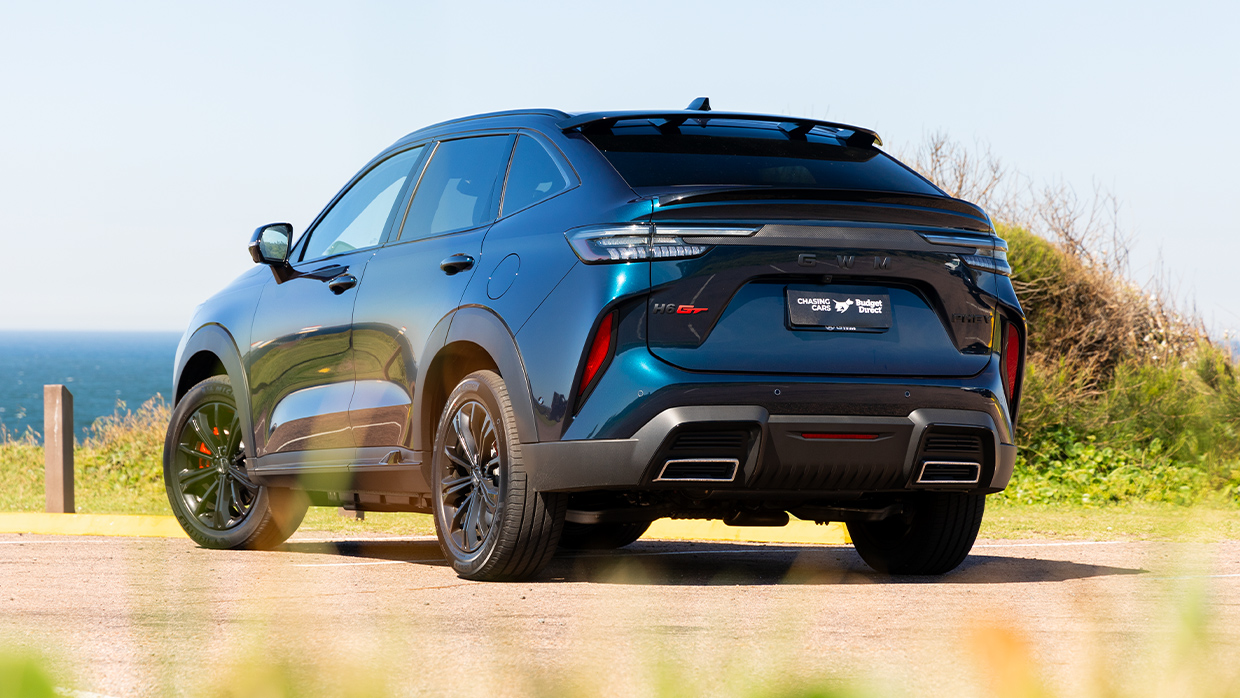
There’s work to do on personality, too. The H6 GT PHEV doesn’t have a discernible character and, with this styling, it should. Perhaps newly-employed chassis guru Rob Trubiani can help knock the H6 GT into something exciting to drive.
Our tip is to wait for the facelifted GWM Haval H6 plug-in. Its cabin is much-improved for both useability and practicalities, the wagon version has a bigger boot. Improvements to ride and handling on the way; if this gets matched with great value then watch out, BYD Sealion 6.
XPeng G6 Long Range 2025 review
6 months ago

Agreeable but largely unmemorable demeanour forces the G6 to lean on long range and fast recharging to stand out in a seriously crowded market
Good points
- Realistic 500km driving range
- Capable of very quick charging
- Spacious, cleanly-styled cabin
- Decent enough to drive
- Ten-year warranty (for now)
- Good value for money
Needs work
- Brand unproven in Australia
- No guaranteed future resale value plan
- Nannying safety aids
- AWD unavailable here
- Limited-mileage warranty
- Under siege from cheaper rivals
Australia is in the midst of an onslaught of newly-arriving Chinese car manufacturers. It is probably the case that some will survive here, and others will not—but XPeng might have more staying power than most.
In 2023, the Volkswagen Group tipped AUD$1 billion into the Guangzhou marque for a forthcoming shared electrical architecture. We’ll see the fruits of that transaction later. Right now, Australians can buy the XPeng G6.
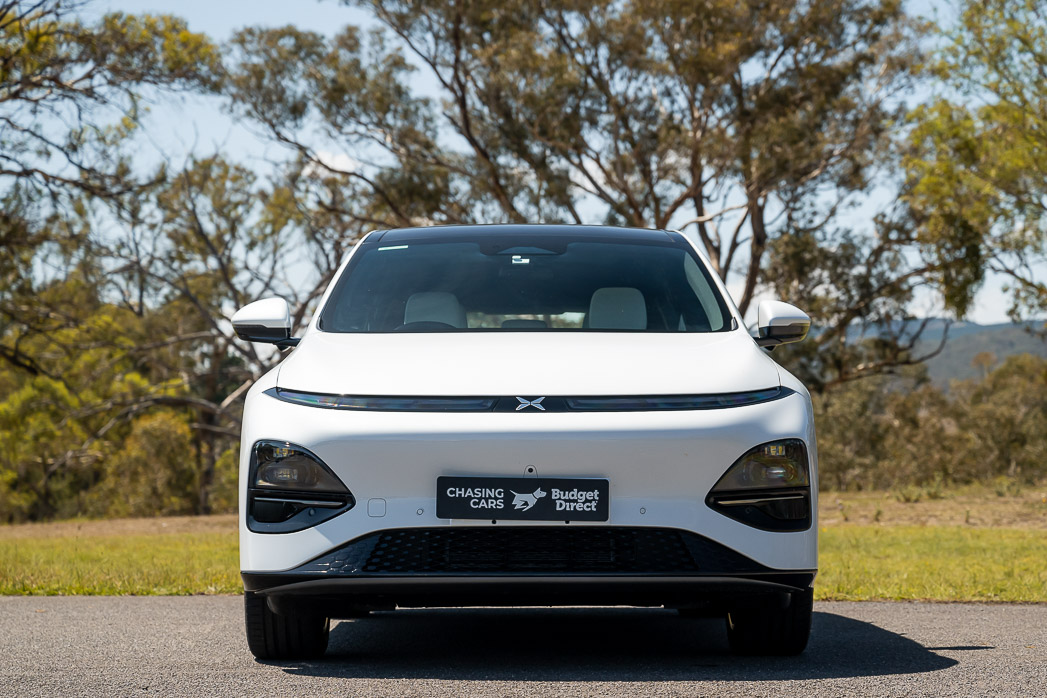
Far East Movement sang about a $124 million Gulfstream G650 private jet in their 2010 banger Like a G6… but this G6 is more attainable. Two variants are available. The G6 Standard Range ($54,800 before on-road costs) is fully specified; the $59,800 G6 Long Range tested here swaps in a larger battery, upgrading range from 435km to 570km (WLTP).
But what is an Xpeng G6 I hear you ask? Dear reader — if the images don’t make it abundantly clear, the G6 looks (almost impossibly) like a slightly blander interpretation of the pre-facelift Tesla Model Y. Such similarities can be measured: the G6 is just 3.0mm longer than the Tesla!
We suppose there are worse commercial decisions than to be inspired by the world’s best-selling vehicle in 2023 and 2024.

Still, it would be quite wrong to label the G6 a photocopy of the Model Y, because that isn’t the case. For one thing, XPeng has seen fit to give this reasonably affordable crossover a sophisticated 800-volt platform —meaning it can charge a lot faster than most EVs at this price point. The interior’s a tad more conventional than a Tesla, too.
When we tested the G6, the canny price strategy became clear. XPeng will sell you a G6 Long Range with 570km range for just $900 more than the cost of a Model Y Rear Wheel Drive. The G6 can go 104km further. You can buy a Model Y Long Range AWD, adding a second motor with 551km range, but that car costs $68,900…
So the price sounded pretty good … until Hangzhou-based rival Geely ruined the party, announcing in recent weeks that its (slightly shorter) EX5 midsizer would cost just $40,990, with 435km range — or $44,990 (both before on-road costs) in closer-matched Inspire trim.

That is a problem. Neither XPeng nor Geely have any brand reputation in Australia. Both cars seem to be competent-enough yet unmemorable Chinese EVs.
Can the G6 avoid being trampled by rivals that are clearly willing to kneecap their compatriots on price? Can the XPeng avoid being entangled in a race to the bottom? Let’s see if this egg-shaped SUV has the distinction required for Australians to take a gamble on this new brand.
What are the G6 Long Range’s features and options for the price?
Despite global EV demand wobbles, the fully electric market continues to be fairly buoyant in Australia due, in large part, to substantial tax savings available to buyers who salary-sacrifice a battery vehicle. At the same time, Australians buy more more midsize SUVs than any other type of car.
The result? An explosion in the number of choices in the electric medium crossover segment that the XPeng G6 joins.

Rapid price changes have become a hallmark of the affordable midsize electric SUV segment that is home to the XPeng G6, but at the time of testing, pricing of the competitive set was pegged as follows, with WLTP driving range given to provide additional perspective:
| Model | Power | WLTP range | Price BOCS | $/range ratio |
|---|---|---|---|---|
| Geely EX5 Inspire | 160kW FWD | 410km | $44,990 | $109/km |
| Leapmotor C10 Design | 160kW RWD | 420km | $49,888 | $118/km |
| Skyworth BE11 Luxury | 150kW FWD | 489km | $52,990 | $108/km |
| Deepal S07 | 160kW RWD | 475km | $53,900 | $113/km |
| XPeng G6 Standard Range | 190kW RWD | 435km | $54,800 | $125/km |
| BYD Sealion 7 Premium | 230kW RWD | 482km | $54,990 | $114/km |
| Tesla Model Y Rear Wheel Drive | 255kW RWD | 466km | $58,900 | $126/km |
| XPeng G6 Long Range | 210kW RWD | 570km | $59,800 | $104/km |
| Volkswagen ID4 Pro | 210kW RWD | 544km | $59,990 | $110/km |
| Cupra Tavascan Endurance | 210kW RWD | 534km | $60,990 | $114/km |
| Kia EV5 Air Long Range | 160kW FWD | 555km | $61,170 | $110/km |
| Smart #3 Premium | 200kW RWD | 455km | $61,900 | $136/km |
| Toyota BZ4X | 150kW FWD | 436km | $66,000 | $151/km |
| Tesla Model Y Long Range AWD | 378kW AWD | 551km | $68,900 | $125/km |
| Skoda Enyaq Sportline | 210kW RWD | 561km | $69,990 | $124/km |
The options seem overwhelming, but the above table makes clear that the G6 Long Range is pretty good value for drivers that need to do long distances. Several rivals splash lower entry costs but the XPeng effectively charges just $104 for each driveable kilometre — far beneath the $126/km of the Model Y Rear Wheel Drive.
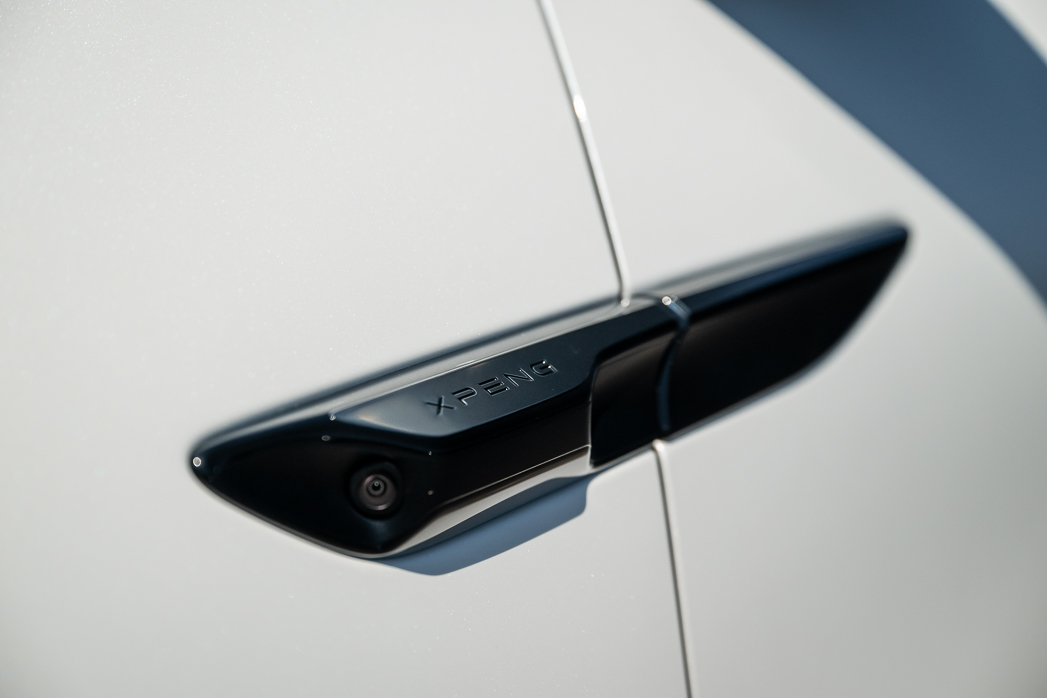
While we’re at it, the same formula shows why the G6 Standard Range is considerably less appealing ($125/km), but also that Geely ($109/km), Skyworth ($108/km) and Volkswagen ($110/km) have each managed to achieve a low price-for-range ratio.
Unlike Tesla, XPeng has not chosen to differentiate the Standard Range and Long Range versions of the G6 by increasing the standard equipment of the latter beyond fitment of a larger battery.
Aside from an extra 20kW, the $5000 upgrade buys 21.5kWh more usable battery ($232/kWh) for a 135km range increase ($37/km).

As a result, the below list of XPeng G6 features applies to both variants:
- 20-inch sport design alloy wheels with 255/45 R20 Michelin tyres
- Passively damped suspension (double wishbone front, multi-link independent rear)
- Adjustable regenerative braking
- LED headlights, LED taillights with ‘lightsaber’ design
- Fixed (non-opening) panoramic glass roof
- Artificial leather upholstery in white or black
- 10-way driver and six-way passenger power-adjustable seats
- Heated and ventilated front seats, heated rear outboard seats
- Heated leather steering wheel
- 14.96-inch central touchscreen with Xmart operating system
- 10.2-inch digital instrument cluster
- Wireless and wired Apple CarPlay and Android Auto
- 18-speaker Xpeng Xopera stereo
- Three USB-C ports (one 60-watt, two 15-watt); one USB-A port (10-watt)
- Dual 50-watt wireless device chargers
- Dual-zone climate control air conditioning with PM2.5 filter
- Smartphone app with unlocking, remote climate and other functions
- Over-the-air software update capability
- Type 2 to Type 2 charging cable (7.5 metre)
- Type 2 to 10-amp household power point charging cable
The only options for Australian buyers of the XPeng G6 relate to colour—and impressively, none of the personalisation attracts any premium. Externally, a choice of Midnight Black, Graphite Grey, Fiery Orange, Silver Frost or the tested Arctic White is offered. Inside, black or white leatherette themes are available, with our car featuring the latter.
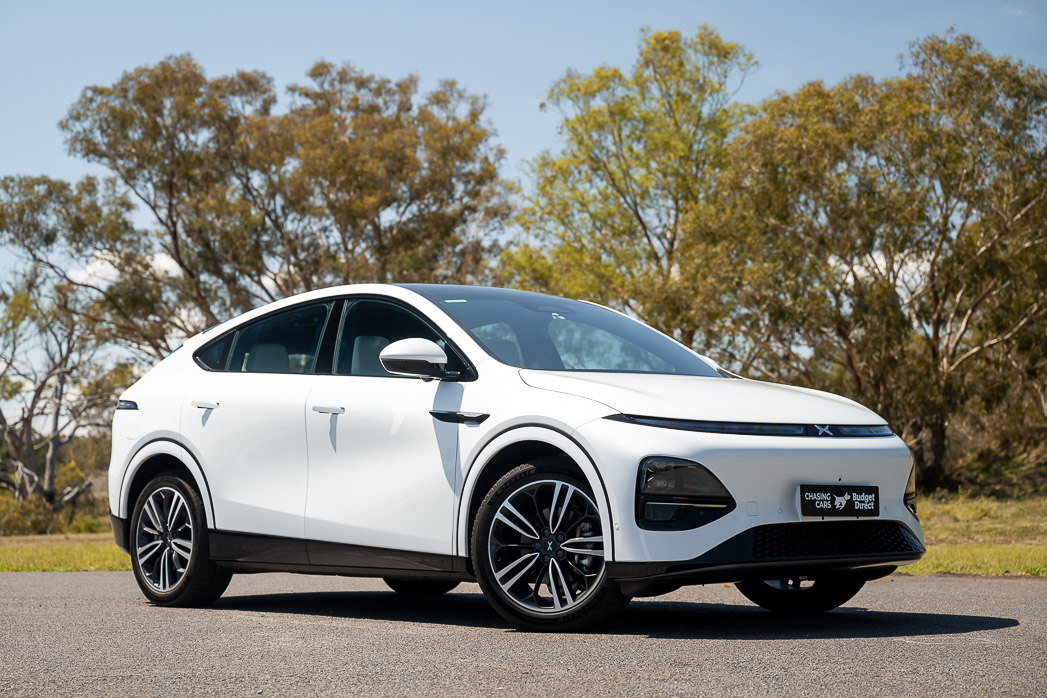
It’s foreseeable that XPeng might choose to offer a lower-tier variant to compete more closely on price with cheaper rivals, but globally, for the time being, the company appears to be exclusively producing a specification more-or-less in line with the above feature set.
How does the G6 Long Range drive?
We had the rare opportunity to independently test the XPeng G6 on some of our very favourite driving roads.
The fast and technical routes on the western side of the Australian Capital Territory reveal unfinished and unpolished dynamics, while the same jurisdiction also offers up some brutally pockmarked urban routes. In other words, a good shakedown for an unknown car from an unknown brand.

And you know what? The dynamics of the XPeng G6 are competent for use on Australian roads, even tough ones like these. That is not to damn the G6 with faint praise. It’s better than several rivals, most controversially the dramatically undercooked Kia EV5 which was (coincidentally) tested alongside the XPeng on the same routes.
However, while the dynamics of the G6 are absolutely acceptable, displaying polite manners and conveying occupants from A to B without a fuss, it is also true to say that the XPeng is a characterless and unmemorable drive.
It depresses us to concede that for most, that won’t be a demerit, but some rivals (namely the Volkswagen Group’s VW ID4, Cupra Tavascan and Skoda Enyaq cousins—even the Toyota BZ4X!) are also rewarding to drive.
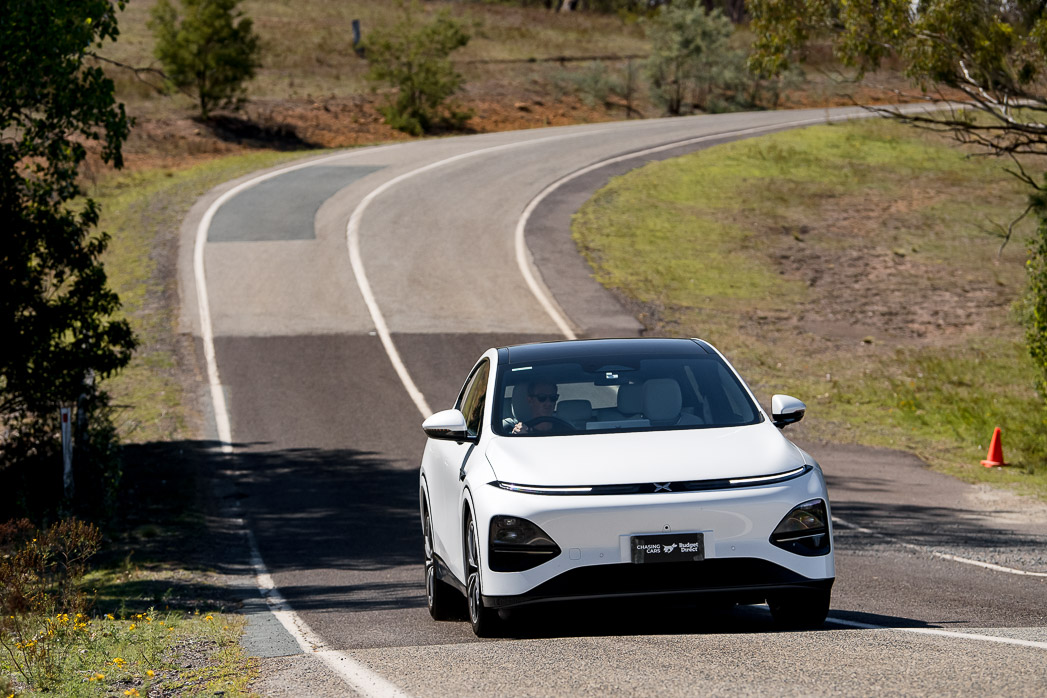
Image captured on private test-track
For those who’ve read far enough to care about this kind of thing, the reason the G6 is so dynamically dull is because its steering and suspension have been tuned to match the visual reference of the car: blandly and conservatively, but in the end … competently. It’s quick (6.2 seconds 0-100km/h) but energy (210kW/440Nm) delivery is safe and linear.
The steering is light (better than being needlessly heavy) but delivers no road feel at all. Grip levels are sufficient, but the tyres will squeal when pushed. The stability control system bites down as things get out of hand.
The dampers bob along quite softly; overall the body control slightly lacks discipline but it’s never rollicking. The control surfaces are vaguely in sync — but you never get the feedback required to want to push on.
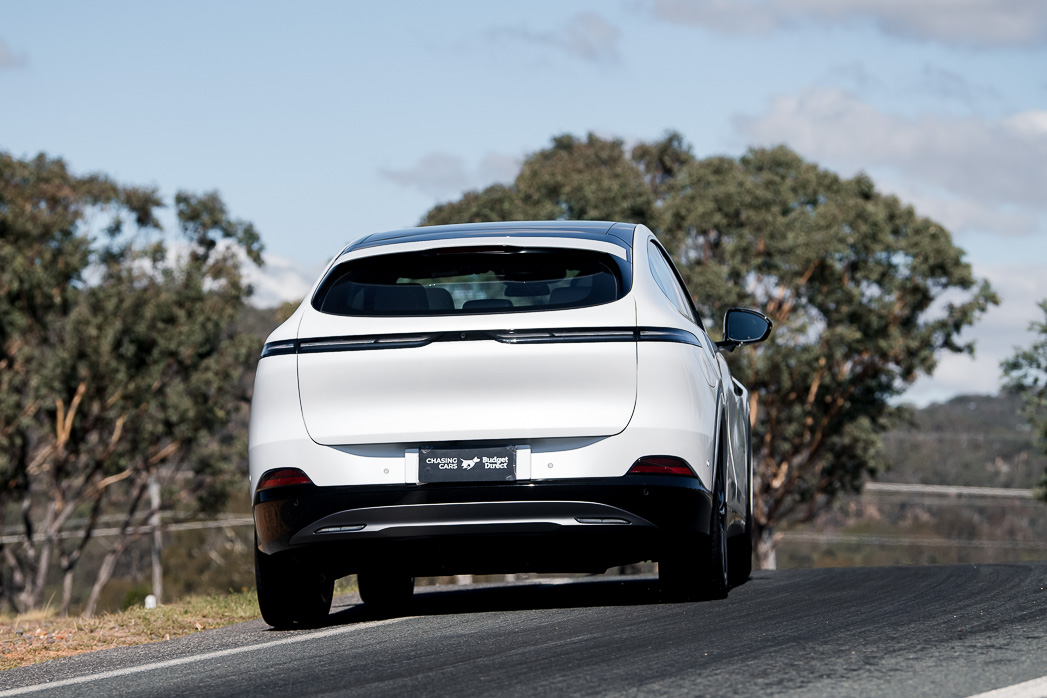
In the end it’s relaxing — once you’ve turned down or deactivated some of the G6’s safety systems, that is, and once you have gotten used to the slightly odd grip required to hold the two-spoke steering wheel.
You won’t drive the G6 for sport; you won’t look for reasons to drive it, but when you do have to, it’s a comfortable, fairly quiet, entirely inoffensive proposition.
We appreciate that the G6 is rear-wheel drive, which does lend a glimmer of poise (even if its character probably wouldn’t have been too different if the motor was at the front). And features like the adjustable regenerative braking work well, with a one-pedal drive mode for those that want it.
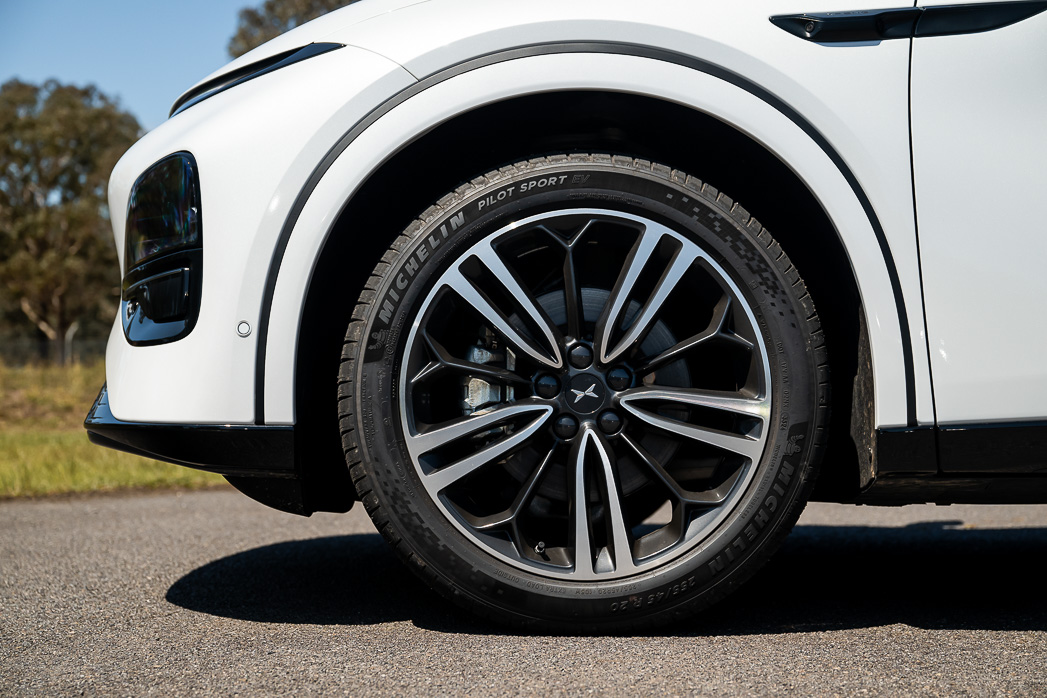
Also, the presence of a proper driver’s instrument cluster makes for easier reference to the speedo on the go than in the Tesla Model Y.
In urban environments, the ride quality on passive dampers and standard 20-inch wheels (with fairly low-profile Michelin tyres) is, again, acceptable. Bigger bumps and imperfections will jar occupants more than a chunkier tyre setup would but, frankly, low-speed comfort is decent enough and head-toss is minimal.
What is the G6 Long Range’s interior and tech like?
As with the exterior design, XPeng appears to have taken some inspiration from the segment-stopping Model Y inside — but where the Model Y has arguably subtracted too much hardware, the G6 cabin designers have seen fit to add some things back in.
In that sense, the G6 is marginally more conventional — but for anybody getting out of a mainstream car, the XPeng’s interior is certainly a futuristic and interesting space.
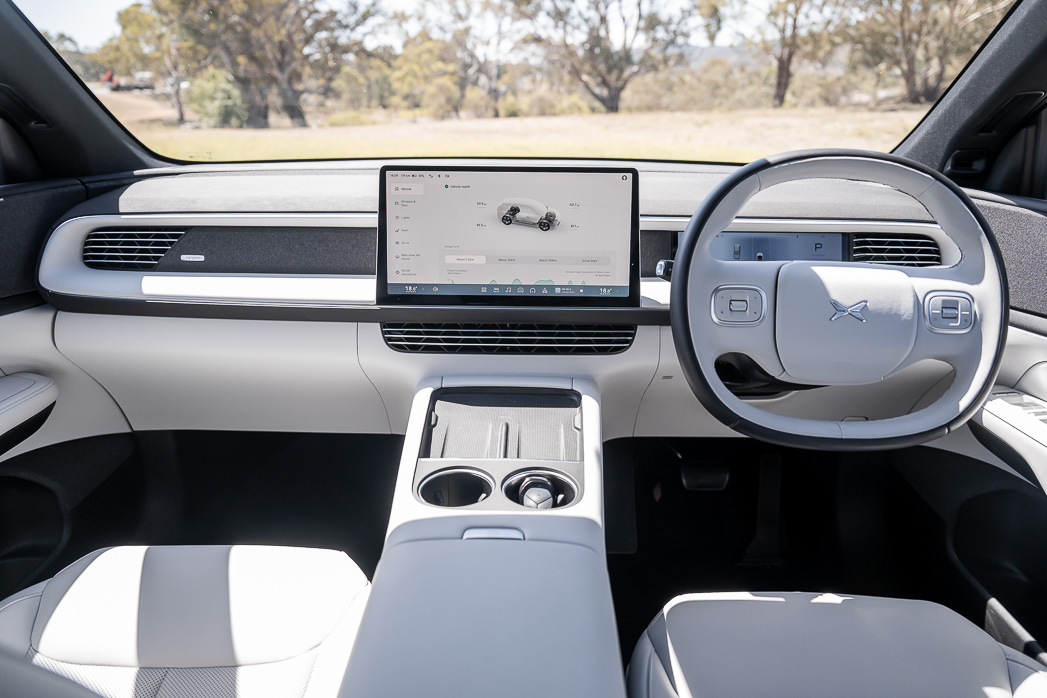
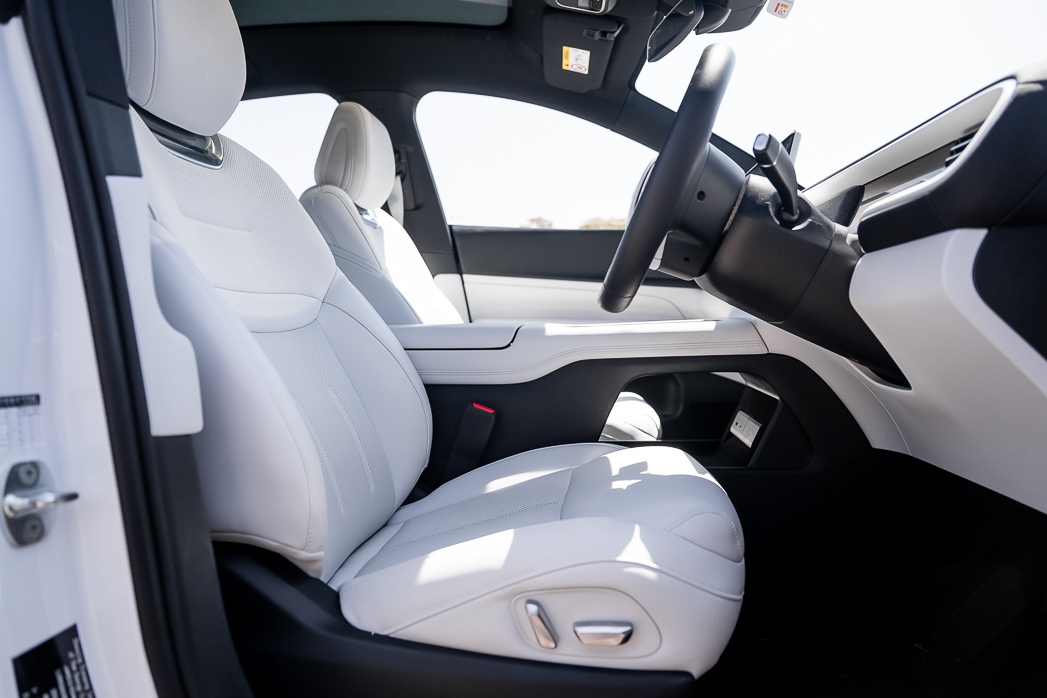
The black interior colour scheme seems dark and foreboding, which might explain why XPeng sent us the (no-cost optional) white cabin. The five seats, steering wheel hub and spokes and centre spine are all covered in spongey imitation-leather upholstery while the carpets, door and dash tops and wheel rim are dark.
We wouldn’t call the interior luxurious or especially rich, but it is well-executed and slightly elevated for a mainstream vehicle. It isn’t real leather that has been splashed about the place but rather a vaguely decent facsimile that will at least be easy to wipe down.
The aesthetic is smart and stark, with brightness enhanced from to the standard fitment of yet another fixed panoramic glass roof that we imagine must be nice in the Nordics, but in any country that experiences hot summers, the cabin roasts — as it did on our testing day.
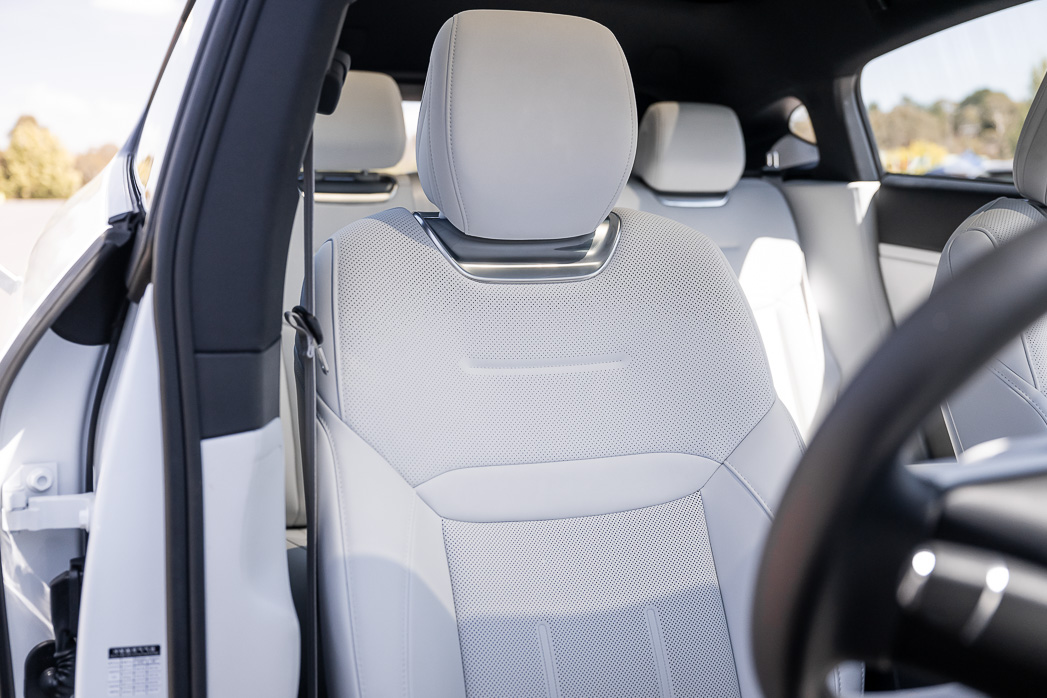

Thankfully, there are two fixes: the vinyl front seats have an effective ventilation feature, and XPeng will sell you a $160 sunshade. We’d recommend fitting it.
Up front, ergonomics are marginal. Both seats are power-adjustable, but XPeng has failed to specify seat base tilt adjustment—and the passenger doesn’t even have adjustable lumbar (the driver has four ways of it, plus memory). As mentioned above (see Driving), the avantgarde steering wheel looks cool, but is strange to hold due to thick spokes.
However, various controls are within easy reach including a stalk for indicators and a column-shifted direction selector. Other oft-requested functions like the dual-zone climate controls are housed within the 15.0-inch central touchscreen that runs Xmart software — though the menu structures are logical, and the system is snappy.
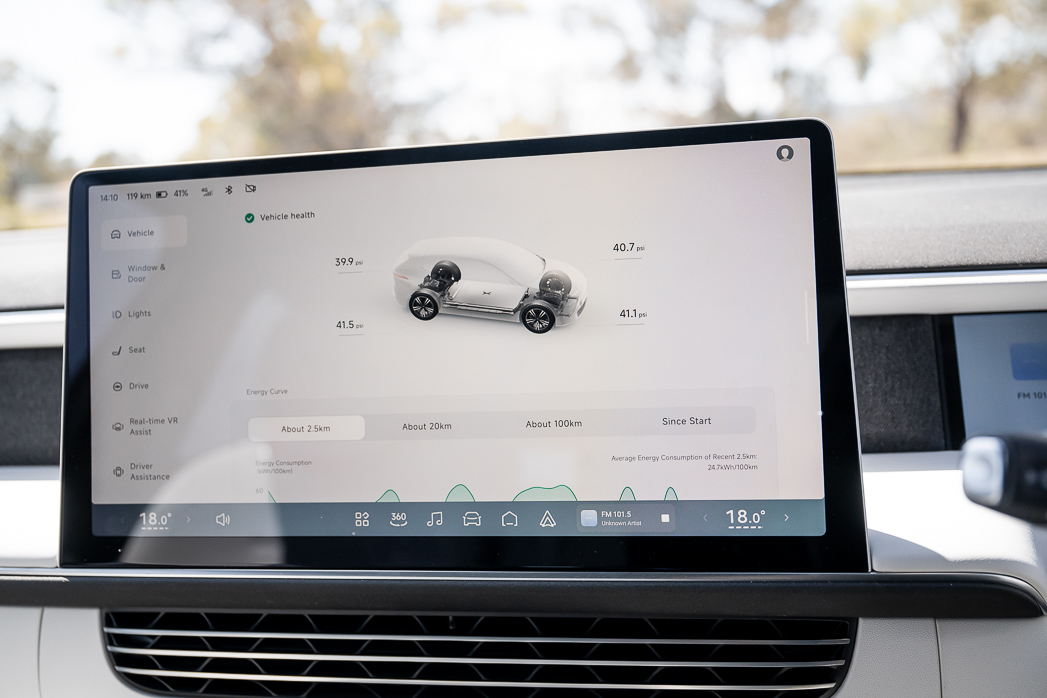
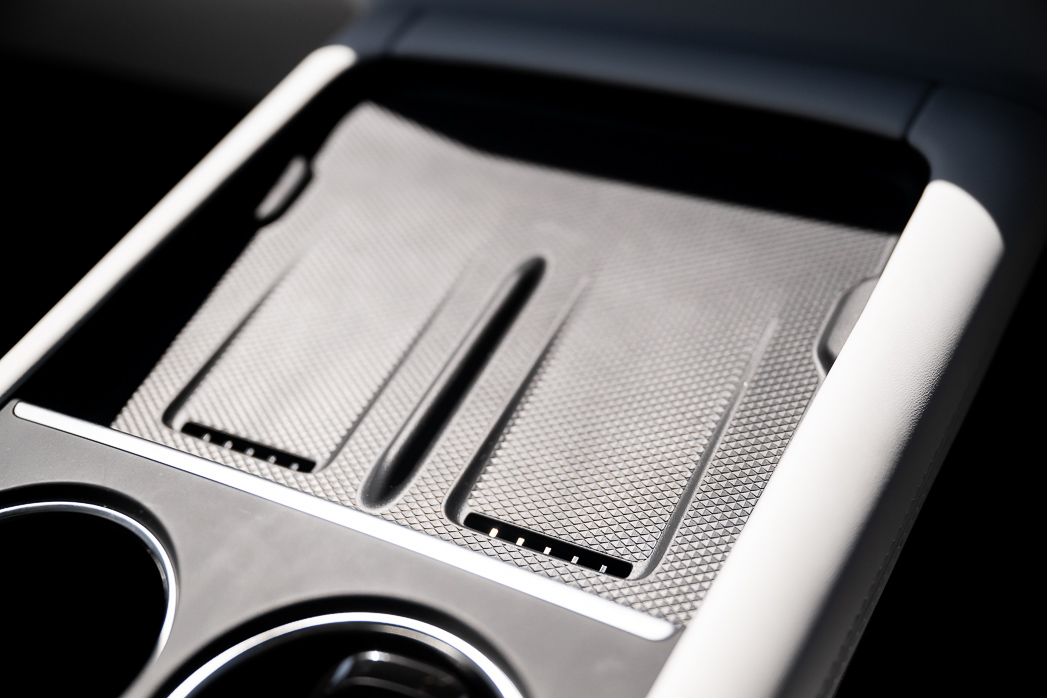
Most people will simply run their phone through the bright and crisp screen as both wireless and wired Apple CarPlay and Android Auto are fitted. Charging devices is a doddle: twin 50-watt wireless chargers are found up front, while the car features one 60-watt USB-C port (good for charging laptops) and a smattering of lower-powered plugs too.
We like the fitment of a 10.2-inch dedicated cluster for the driver with some scrollable display functions (just having a speedo in our line of sight is pleasant, at least when compared to a Model Y), and sound quality from the standard 18-speaker in-house premium stereo was very clear.
Moving to the rear, comfort levels are high thanks to the reasonably long 2890mm wheelbase and significant quantum of rear legroom—six-foot adults will be comfortable in the rear and longer legs are adequately supported by a well-designed seat base. Air vents and USB charging is available in-back while squidgy plastics continue into row two.
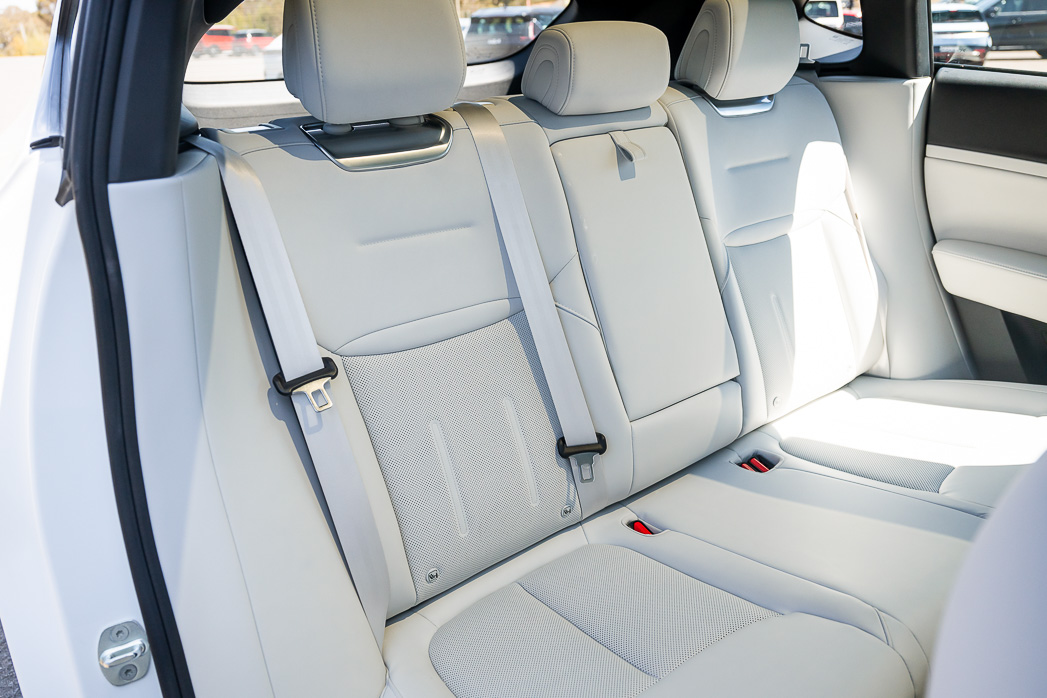

Oddly for a rear-wheel drive car on a dedicated EV platform (in this instance XPeng’s SEPA 2.0 architecture), there is no frunk beneath the bonnet—but there is a large boot.
Behind a power tailgate waits 571 litres of cargo space with reasonable width and a low loading height making packing stuff easy, while the rear seats split fold for longer items.
Like nearly all electric vehicles there is no spare wheel or tyre fitted beneath the boot floor. There is a space for cables, two of which are included in the purchase price.
Is the G6 Long Range a safe car?
Yes, the G6 is safe, but like with many vehicles we test, the tuning of some of the safety features fitted to the car to achieve a high safety rating are intrusive and poorly-tuned in reality. The crash and safety credentials have been independently rated by Australasian New Car Assessment Program (ANCAP), though results are translated from results recorded by Euro NCAP.
Consequentially, the XPeng G6 received a five-star ANCAP crash and safety rating under the body’s 2024 protocol, with the rating due to expire in December 2030. Individual scores recorded by the G6 were as follows:
- 88 percent for adult occupant protection (35.49 out of 40 points)
- 86 percent for child occupant protection (42.62 out of 49 points)
- 81 percent for vulnerable road user (pedestrian, cyclist and motorcyclist) protection (51.50 out of 63 points)
- 80 percent for safety assistance technologies (14.49 out of 18 points)
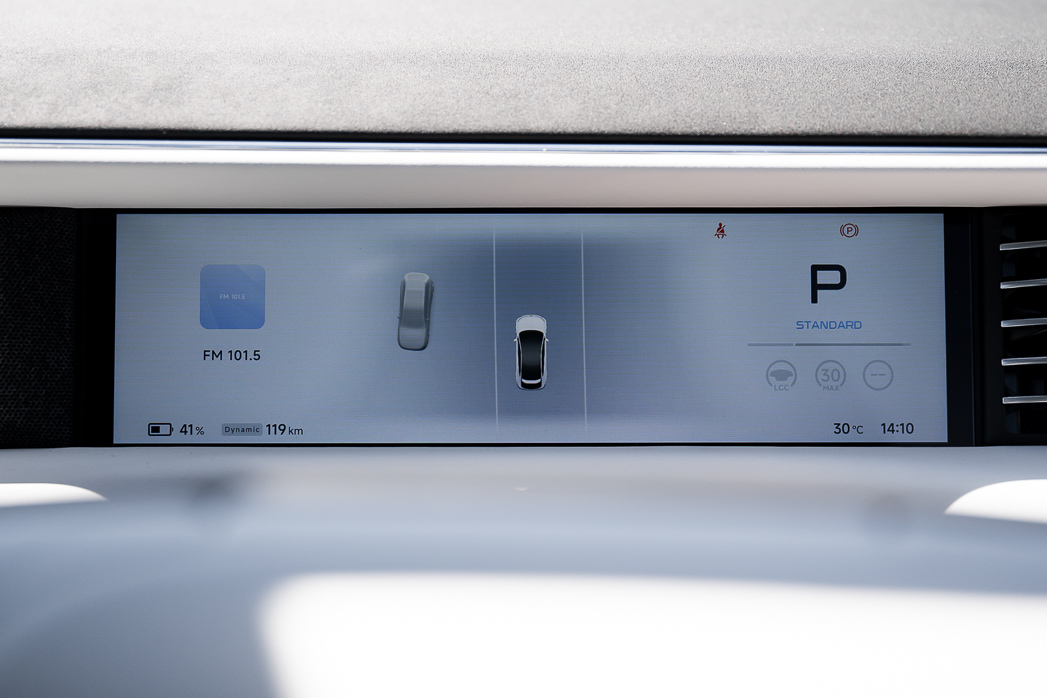
While the crashworthiness of the G6 was rated highly, the following adaptive safety technologies are fitted as standard to the car within XPeng’s Xpilot driver assistance suite that is powered by an NVIDIA Orin-X chip, five millimetre wave radar, 12 ultrasonic sensors, and 12 cameras:
- Autonomous emergency braking (detecting cars, pedestrians, motorcyclists and cyclists), including forward collision warning
- Junction AEB detecting oncoming cars
- Reversing AEB
- Adaptive cruise control
- Lane centring technology with lane keeping assistance
- Blind spot monitoring
- Rear cross-traffic alert
- Enhanced automated parking
- Traffic sign recognition
- Automatic high beam activation
- 360-degree parking camera
- Driver attention monitoring
These systems worked reasonably well, with the 360-degree parking camera providing a clear view of surroundings. We also observed satisfactory performance from the lane centring system on the highway.
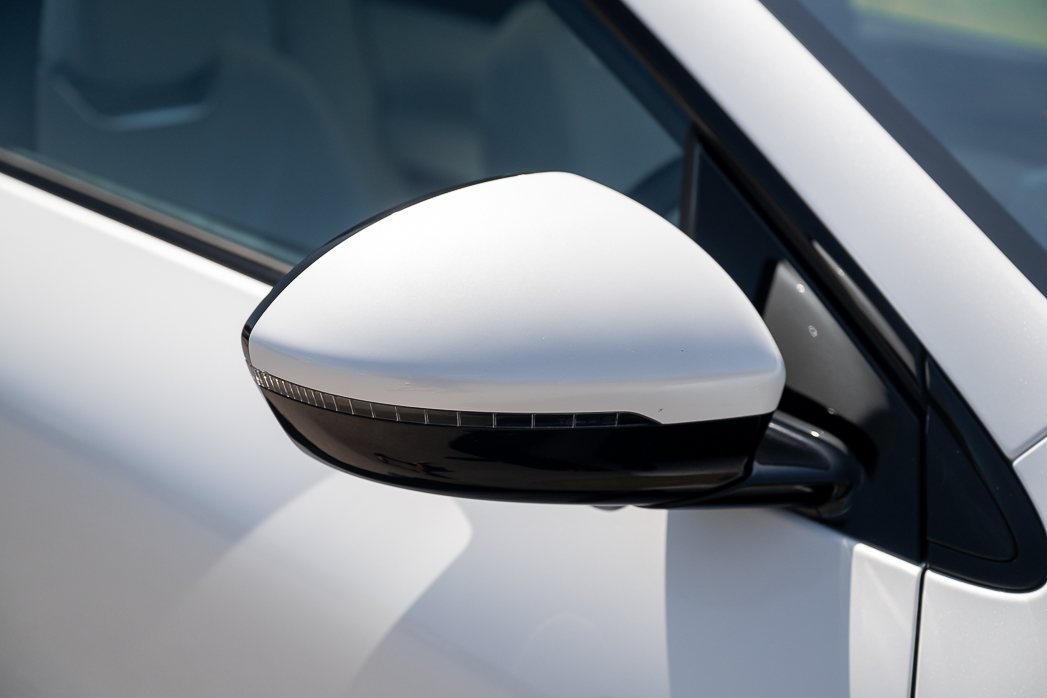
However, during suburban and country road driving, the lane-keeping system was oversensitive, and both the speed warning and driver monitoring systems were overbearing and occasionally inaccurate. As a result, we learned a routine to deactivate those features on most drives via the touchscreen.
What are the G6 Long Range’s ownership costs?
Like most EVs, the XPeng G6 promises low running costs for owners who can charge the vehicle at home, making use of fixed or off-peak electricity tariffs—or solar if the car can be fuelled during the day.
The G6 Long Range has an 87.5kWh (usable) NMC battery. Consumption is rated at 15.4kWh/100km (WLTP) for a range of 570km. We managed 17.0kWh/100km in mixed driving for realistic range of 514km — that’s still solid.
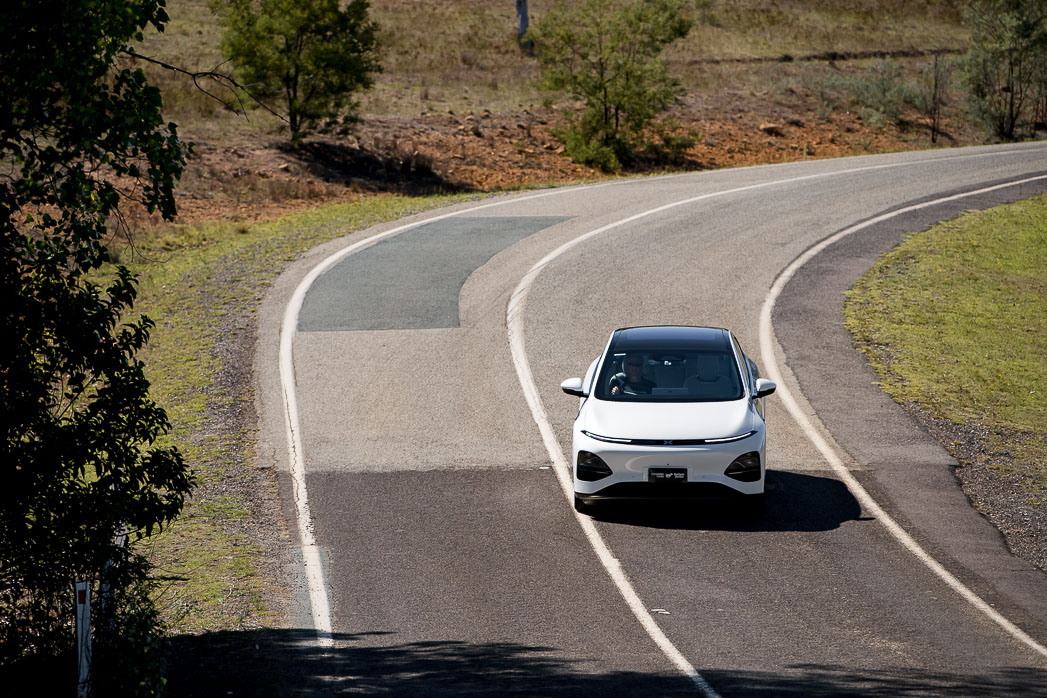
Recharging at home with a tariff of $0.35/kWh, a full charge would cost about $33 including losses — or $6 per 100km. If you rely on public chargers, at a given rate of $0.65/kWh, a realistic replenishment from 10 percent to 80 percent state of charge would cost around $42 ($12 per 100km), again considering charging losses.
For comparison purposes, 100km of driving could cost around $16 in a combustion SUV of similar size.
Charge times vary. Domestically, a simple 10-amp general power outlet allows the G6 to take on about 22kWh in 12 hours (129km).
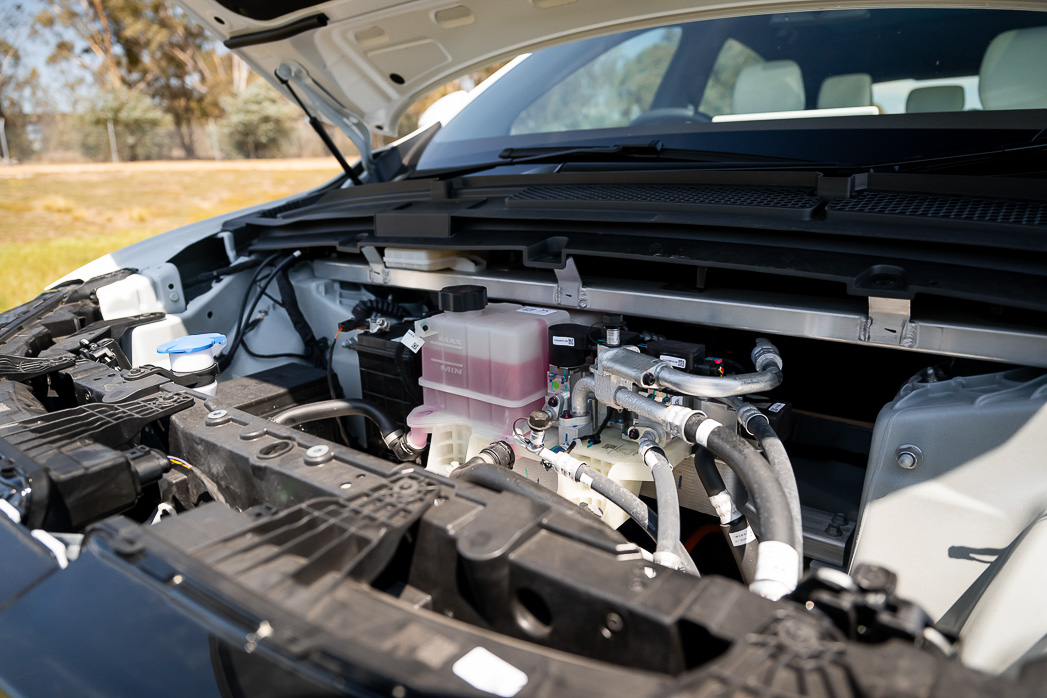
Upgrading to a wallbox at a cost of about $2000 allows you to fully recharge overnight. In a public charging environment, the G6’s 800-volt platform allows it to peak at a charge speed of 280kW and average a very quick 180kW across a 10-80 percent charge session of 21 minutes.
XPeng has extended a campaign of cheaper servicing costs and longer warranties for Australian buyers — this time, nominally, until June 30, 2025.
Under this campaign, five years or 100,000km of scheduled maintenance will cost $1826 in total, while the vehicle warranty is extended from the standard five years/120,000km to 10 years/220,000km, and the battery warranty pushes out from eight years to 10 years.
The honest verdict on the G6 Long Range
The XPeng G6 has decent manners and a reasonable price in far-reaching Long Range format. The biggest problem this Chinese-made newcomer will face is asking Australians to entrust an untested marque with their hard-earned dollars.
Questions of long-term reliability and resale value are naturally untested — this vehicle may turn out to be rock-solid, but we just won’t know until they have spent some time on Australian roads.
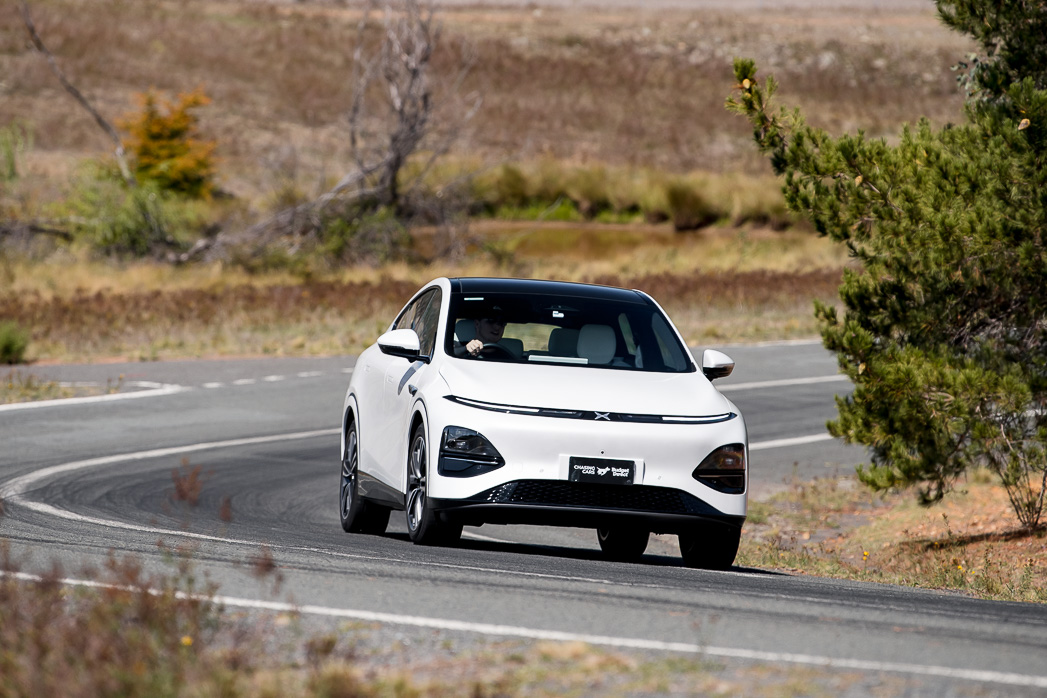
Some manufacturers opt to launch with a guaranteed future value plan to limit customer exposure to depreciation, but XPeng has ambitiously sidestepped such an offer.
It’s your money on the line.
The Australian electric car market is like the Wild West at present: low barriers to entry mean an influx of new brands — and new product lines from the brands you’ve heard of. Which of these new products will last long-term is an open question.

Images captured on private test-track
Purchasing the G6 through a novated lease structure would reduce overall costs further for some buyers — and Australians that need to do long distances and who will benefit from the XPeng’s impressively short highway recharge times may find that this vehicle ticks the boxes.



